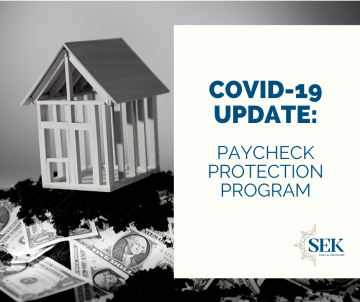Recent News & Blog / PPP clarification for self-employed forgiveness & general information

April 17, 2020
If you have not yet read our previous post on the general information regarding the Paycheck Protection Program loans, click here.
April 17, 2020
Small Business Administration (SBA) guidance covering Sole Proprietors with insight to some forgiveness provisions of the Paycheck Protection Program (PPP) can be found here.
Below are some facts that are 100% Sole Proprietor specific and some that will carry over to the larger entity forgiveness calculations – page numbers of SBA document are in parentheses.
100% Sole Proprietor specific:
- Sole Proprietor net is only noted as Net income from Schedule C – specifically line 31 net profit (page 6)
- If you haven’t filed your return yet, you should still complete Schedule C and use it to apply for PPP loan (page 6)
- Health Insurance and Retirement only applies to employees for Schedule C filers (NOT CLEAR whether partners in partnerships can use benefits within the PSHIP application) (pages 7 and 11)
- Sole Proprietor owner compensation replacement is limited to 8/52 of the 2019 net profit (page 11)
- Any payment above 8/52 of 2019 Schedule C profit cannot be paid from loan proceeds
- If 2019 net is under $100,000, take Net Schedule C / 52 weeks x 8 equals the maximum compensation replacement for Schedule C owners
- Limits loan forgiveness to the owner compensation replacement for Sole Proprietors to 8/52 of the Net Schedule C (12)
- Indicates Schedule C filers less likely to have substantial overhead, and therefore limit on this piece of the calculation is to prevent a windfall to the Sole Proprietor
- Because the loan is based on 2.5X average monthly net schedule C, this equates to all Schedule C filers having less than 100% forgiveness and will have some loan remaining
- Unclear whether this relates to the 2.5X piece related to employee wages and benefits – we don’t believe it intends to limit that portion of forgiveness
- Indicates all Schedule C owners (regardless of creditworthiness) are eligible for PPP loans (page 14)
Broad concepts / relate to all forgiveness calculations:
- Confirms active general partners in partnerships MUST apply through the partnership and their compensation is eligible (up to $100,000 annualized) (page 5)
- Interest on auto loans and other business asset loans are eligible expenses (page 9)
- Interest on other debt incurred before 2/15/2020 (debt without a direct security interest in a business asset) can be paid (eligible cost) but will not count toward forgiveness
- It is unclear if a special consideration is warranted for loans that began after 1/1/2020 but before 2/15/2020
- This interest is certainly eligible but could potentially not be treated toward forgiveness
- It is unclear if a special consideration is warranted for loans that began after 1/1/2020 but before 2/15/2020
- Rent of personal property (equipment rents) are eligible expenses (page 9)
- Eligible costs include up to $100,000 annualized salary equals $15,385 maximum for each employee equals 8 weeks of payroll (page 11)
- Does not appear to limit paying an employee more than what they earned in 2019 but eligible maximum is $15,385
- References benefits for employees, but not owners – drawing into question partners health and pension (page 11)
- Not sure if this is specific to Schedule C – Sole Proprietors or not
Please keep in mind that this is only an interpretation of the rules. We will continue to update as more information becomes available.
Additionally, more information on forgiveness is available on the American Institute of CPA’s PPP FAQ website.